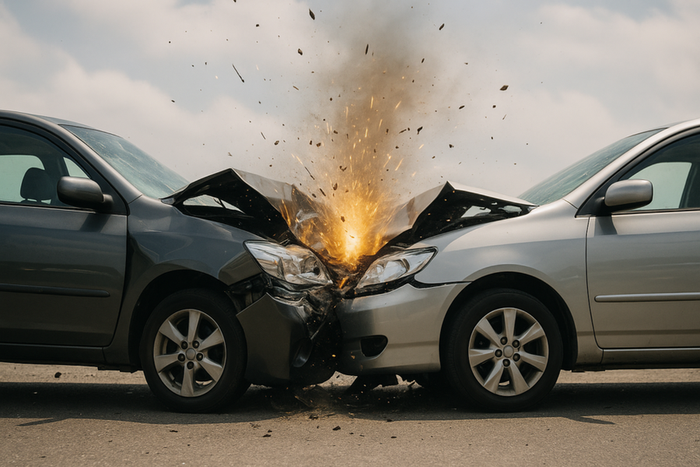Head-on collisions are among the most devastating traffic accidents that occur on Phoenix roadways. Despite accounting for only about 2% of all crashes nationwide, these accidents result in a disproportionate 10.1% of fatal crashes, according to the National Highway Traffic Safety Administration (NHTSA)[^1]. In Phoenix, where high-speed roadways intersect with busy urban traffic, these collisions pose a significant danger to motorists.
The Devastating Impact of Head-On Collisions
Head-on collisions occur when two vehicles traveling in opposite directions strike each other front-to-front. The physics behind these crashes explains their severity: the force of impact equals the combined speed of both vehicles. For example, when two vehicles traveling at 45 mph collide head-on, the impact force is similar to a single vehicle hitting a solid wall at 90 mph.
According to the Insurance Institute for Highway Safety (IIHS), frontal impacts cause approximately 57% of passenger vehicle occupant deaths[^2]. In Arizona specifically, the Department of Transportation reports that head-on collisions account for a significant portion of the state’s traffic fatalities each year, with many occurring in Maricopa County where Phoenix is located.
Common Causes of Phoenix Head-On Collisions
Several factors contribute to the prevalence of head-on crashes in the Phoenix metropolitan area:
- Wrong-Way Driving: Arizona has been battling a serious wrong-way driving problem. According to the Arizona Department of Transportation (ADOT), there were 1,730 reported wrong-way incidents in 2021, prompting the installation of a thermal detection system on Phoenix freeways to alert authorities to wrong-way drivers.[^3]
- Impaired Driving: The Arizona Governor’s Office of Highway Safety reports that impaired driving remains a leading cause of wrong-way driving incidents and head-on collisions. In fact, studies show that over 60% of wrong-way drivers involved in fatal crashes had blood alcohol concentrations above the legal limit.[^4]
- Distracted Driving: In violation of A.R.S. § 28-914, which prohibits texting while driving in Arizona, distracted driving continues to be a significant factor in lane departure crashes leading to head-on collisions.
- Fatigued Driving: The monotony of long desert highways surrounding Phoenix can contribute to driver fatigue, causing motorists to drift into oncoming traffic.
- Hazardous Road Conditions: Poor road design, inadequate signage, or missing barriers on Phoenix roadways can increase the risk of head-on collisions.
Phoenix Head-On Collision Statistics and High-Risk Areas
The Maricopa Association of Governments (MAG) has identified several high-risk corridors in the Phoenix area where head-on collisions are more common:
- Interstate 17, particularly in the northern stretches
- The Loop 101 and Loop 202 interchanges
- Rural highways connecting to the metropolitan area
- Major arterial roads with two-way left turn lanes
The Arizona Department of Public Safety (DPS) records show that wrong-way driving incidents are most common between 12 a.m. and 2 a.m., with the highest concentration occurring on weekends.[^5]
Understanding Arizona Law and Head-On Collision Liability
Arizona follows a “comparative negligence” system under A.R.S. § 12-2505, meaning that compensation may be reduced by the percentage of fault attributed to each party. For head-on collision victims, establishing the other driver’s liability is crucial to maximizing compensation.
Key legal considerations include:
- Statute of Limitations: Under A.R.S. § 12-542, victims generally have two years from the date of the accident to file a personal injury lawsuit. Missing this deadline typically bars recovery.
- Potential Defendants: Beyond the other driver, additional parties may bear responsibility. These might include:
- Government entities responsible for road design or maintenance (subject to specific notice requirements under A.R.S. § 12-821.01)
- Vehicle manufacturers if defects contributed to the collision or injuries (governed by Arizona’s product liability laws)
- Employers of drivers who were on-the-job when the collision occurred
For more comprehensive information about liability in head-on collisions, visit our Car Accident Information Center.
Vehicle Safety Features and Head-On Collision Prevention
Modern vehicles incorporate several features designed specifically to mitigate head-on collision damage. According to data from vehicle manufacturers and the IIHS:
- Crumple Zones: First pioneered by Mercedes-Benz, these engineered structures absorb and distribute crash energy, reducing forces transmitted to occupants.
- Lane Departure Warning Systems: Toyota and other manufacturers report that these systems can reduce head-on collisions by up to 46% by alerting drivers when they unintentionally drift from their lane.[^6]
- Automatic Emergency Braking: According to Honda’s safety research, this technology can reduce collision speeds by up to 31 mph, significantly decreasing injury severity in unavoidable head-on crashes.
Medical Consequences of Head-On Collisions
The Maricopa Integrated Health System, which operates the only Level 1 Trauma Center in Phoenix verified by the American College of Surgeons, reports that head-on collision victims typically suffer more severe injuries than those in other crash types:
- Traumatic brain injuries
- Spinal cord damage
- Multiple fractures, particularly to the lower extremities
- Internal organ damage
- Psychological trauma, including PTSD
Recovery often requires extensive medical treatment, rehabilitation, and sometimes lifelong care. Learn more about catastrophic injuries and their long-term impact on our Catastrophic Injury Information Page.
Pursuing Compensation After a Phoenix Head-On Collision
The Superior Court of Arizona in Maricopa County processes numerous head-on collision cases each year. These claims typically seek compensation for:
- Medical expenses (current and future)
- Lost wages and diminished earning capacity
- Property damage
- Pain and suffering
- Loss of enjoyment of life
- In fatal cases, wrongful death damages under A.R.S. § 12-611
The court is located at 201 W. Jefferson Street in downtown Phoenix, where civil cases including personal injury lawsuits are filed and litigated.
For victims of head-on collisions, the path to fair compensation often involves complex legal challenges. Insurance companies frequently attempt to minimize payouts or shift blame, making experienced legal representation essential. For personalized guidance on your specific situation, our Phoenix Auto Accident Guide provides valuable resources.
ADOT’s Efforts to Prevent Head-On Collisions
The Arizona Department of Transportation has implemented several measures specifically targeting wrong-way driving and head-on collisions:
- Thermal camera detection systems on I-17 that immediately alert DPS and activate warning signs
- Enhanced “Wrong Way” signage with reflective borders
- Lane separators and median barriers on high-risk roadways
- Public awareness campaigns focusing on impaired driving prevention
These efforts have shown promise in reducing wrong-way incidents, though the problem remains significant in the Phoenix metropolitan area.
Steps to Take After Being Involved in a Head-On Collision
If you’ve been involved in a head-on collision in Phoenix:
- Seek immediate medical attention, even if injuries seem minor
- Report the accident to law enforcement and obtain the police report
- Document the scene with photos if possible
- Obtain contact and insurance information from all involved parties
- Avoid discussing fault or making statements to insurance adjusters
- Consult with an experienced personal injury attorney familiar with Arizona law
Conclusion
Head-on collisions in Phoenix represent some of the most serious traffic accidents on Arizona roadways. With their catastrophic consequences and complex legal considerations, these cases demand specialized knowledge of both medicine and law. By understanding the causes, preventive measures, and legal options, Phoenix motorists can better protect themselves and their legal rights following these devastating crashes.
[^1]: National Highway Traffic Safety Administration. “Traffic Safety Facts: Crash Stats.” DOT HS 812 318. Washington, DC: NHTSA, 2023.
[^2]: Insurance Institute for Highway Safety. “Fatality Facts 2022: Passenger Vehicle Occupants.” Arlington, VA: The Highway Loss Data Institute, 2023.
[^3]: Arizona Department of Transportation. “2021-2022 Motor Vehicle Crash Facts.” Phoenix, AZ: ADOT, 2023.
[^4]: Arizona Governor’s Office of Highway Safety. “2022 Annual Report.” Phoenix, AZ: GOHS, 2023.
[^5]: Arizona Department of Public Safety. “Wrong-Way Driving Incident Analysis 2021-2023.” Phoenix, AZ: DPS, 2024.
[^6]: Highway Loss Data Institute. “Lane Departure Warning Reduces Police-Reported Crashes.” IIHS Status Report, Vol. 52, No. 5, 2022.



